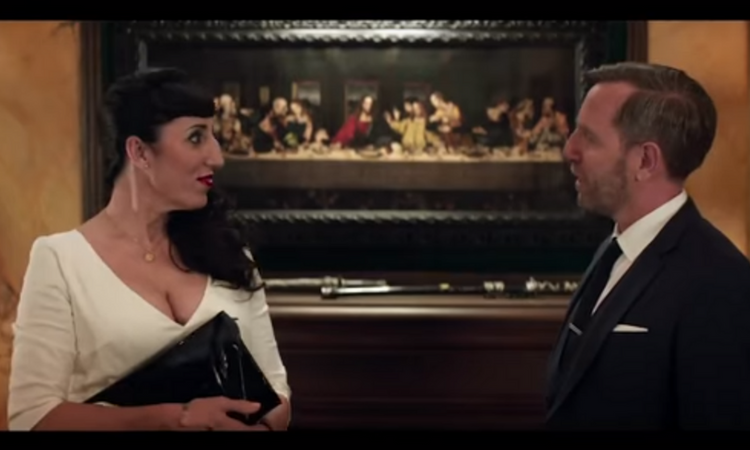
Screenshot from the movie MADAME (2017)
And The Money Changers In The Temple.
How I happened to watch the film, I’m not sure. Perhaps on one of those interminable flights to or from Greece last spring when scraping the bottom of the barrel of viewing choices became a necessity. When sleep, in seats built for midgets, proved so elusive.
In any event, Madame isn’t good enough that you’d want to suffer through a 14 hour flight to take in. But it does have some redeeming qualities. It features the pampered, sexually “liberated” existence of the ultra-wealthy of Paris. And the working stiff, household servants that cater to their every whim. Judging by the consensus of most of the cinematic literati, it has all the of a sparkle of a flute of bubbly gone flat (see here, here, and here).
Something’s Happening. But You Don’t Know What It Is.
And that’s pretty much how it was for me as well. But there was also something that didn’t quite fit.
But, finally, it dawned on me: why did a painting of The Last Supper feature so prominently in a film that most parents would want to slip out the back if their kids were sitting next to them? And that the movie didn’t mock or demonize Christianity-which is so often the only way films seems to be able to treat the subject-was nearly as strange.
No, the painting, and the fortune that it represents, remains serenely in the background, looking on as the weaponized and heartless sexual escapades of this cast of wealthy playboys and girls manipulate each other like so many pieces on a chess board. (In one scene, two of the female antagonists maneuver oversize chess pieces on an oversize chess board.) The painting, by Italian Baroque master, Caravaggio, appears at least 6 times in the show; its larger-than-life financial significance is a topic of conversation even more frequently.
Bob and Anne Fredericks, the expatriate American manipulators in chief, need to sell the painting to pull their financial bacon out of the fire that their opulent Parisienne lifestyle has landed them in. When the picture is finally sold, Bob, who fits the part of the unctuous undertaker down to the ground, watches with satisfaction as the painting is securely nailed in its coffin-like crate. And then borne away by grim faced pallbearers. Earlier, Bob describes the painting as his “grandfather’s greatest acquisition.” Oh, well. When the creditors are hounding you and there’re appearances to be maintained, what’s a Last Supper and family heirloom among friends?
Release The Kraken!
But it’s when the painting’s sold that things get really squirrelly. Anne pairs up with the Frenchman whose wife she confronted on the chess board. Only to be eventually dumped by the husband. Bob canoodles with his much younger French tutor. Maria, a maid who, despite her peasant Spanish Catholic upbringing, carries on with David the art broker/aristocrat who profits handsomely from selling the Caravaggio. Except for Maria and David, around whose two very different worlds the movie wobbles, it’s tough to keep track of all these illicit liaisons without a program.
“I’m Old Fashioned. I Believe In Marriage.”
Just before the credits roll, Maria, an enigmatic smile on her face, is shown confidently striding through the streets of Paris. But towards what, we’re not sure. That she’s leaving Bob and Anne and David, who’ve treated her like so much beige carpeting to be trod on, is certain. But is she just in search of another maid job for the ultra-wealthy, where, if she’s lucky, she can trick another gullible rich guy into believing she’s a Spanish princess?
Maybe. But what would that prove? That’s she’s learned nothing from observing, as only a maid can, just how heartless the rich and famous can be?
But maybe this idea fits better. Amanda Sthers, the director and script writer, in addition to her other achievements, is the divorced mother of two children. At one point in the film, she puts these words in the mouth of Maria, “I’m old fashioned. I believe in marriage.” Unsurprisingly, when Maria makes this pronouncement, the playboys and girls around her shrug it off.
At another point, Maria tells David that “I love the picture of the Holy Family that I have next to my bed.” David, who can’t imagine such things without seeing dollar signs, wonders, “Which master painted it? It must be tremendously valuable.” Kitsch art and genuine feeling collide with the money changer.
Is Ms. Sthers, through one of the film’s only sympathetic characters, telling us what she thinks about marriage and Christianity? Can’t say “Yes” for sure. But neither can I say “No.”
Madame? Or, In Other Words, Mrs.
The title of the movie is odd. The French equivalent of Mrs, does it refer to Anne, the only married woman who has anything other than a bit part? But Anne definitely plays second fiddle to Maria. And Maria, it doesn’t appear, is married.
Turns out, however, that Maria has a teenage daughter that she, apparently, can only mother from afar through FaceTime. An aspiring figure skater, the daughter’s lessons are paid for by Bob and Anne. Fearing that Maria’s involvement with the art dealer might scotch their chances to sell the painting, Anne’s maternal instincts kick in, “You know, Maria, if you can’t get this thing with David under control, we may have to quit paying for your daughter’s skating lessons.” Yep. The maternal instincts of a serpent.
So maybe, just maybe, Maria has resolutely set her face toward resuming her role as something other than a FaceTime avatar for her daughter. And, who knows, even something as wildly old fashioned as a family.
Second Meanings.
C.S. Lewis, in his book, Reflections On The Psalms, says this about hidden meanings in those famous poems. Or, for that matter, movies:
“Hitherto we have been trying to read the Psalms as we suppose-or I suppose-their poets meant them to be read. But this of course is not the way in which they have been used by Christians. They have been believed to contain a second or hidden meaning, an ‘allegorical’ sense . . . Such a doctrine, not without reason, arouses deep distrust in a modern mind. Because, as we know, almost anything can be read into any book [or movie] if you are determined enough. . . (Some of the allegories thus imposed on my own books have been so ingenious and interesting that I often wish that I had thought of them myself.”)
So, am I guilty of “imposing” an ingenious allegorical meaning on Madame that has no business being there?
Of course, I can’t be certain what Ms. Sthers had in mind when she created this movie. Maybe it’s just, as most of the critics believe, a fizzy French nothing burger of a naughty comedy.
But if so, why so obviously give the Last Supper painting pride of place? And which, at least briefly and less than perfectly, holds back the sexual anarchy, angst and greed that prevails after the painting is sold for an inflation adjusted 30 pieces of silver?
But perhaps that’s the real problem with this movie. Maybe Ms. Sthers herself doesn’t know exactly what she wants. A bonbon? Or something with more substance, a commentary on the anomie that besets us when the idols of money and sex trump all other values? And what happens to people who think they’ve succeeded in doing as Pilate directed the chief priests and Pharisees: “You have a guard. Go and make the tomb as secure as you know how.”




